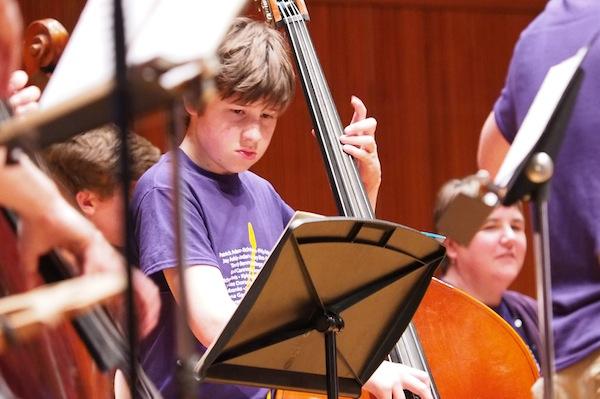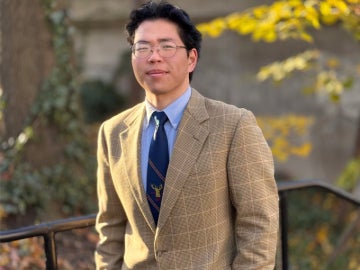Oberlin Hosts First Hinton Institute for Studio Bass
June 19, 2014
Michael Stenovec

The Hinton Institute for Studio Bass welcomes students from age 13 through college.
Photo credit: Dale Preston
The inaugural session of the Milt Hinton Institute for Studio Bass took place on campus June 8-15. The biennial, weeklong program allows bass students at the precollege and college level to experience a range of activities, including performances, master classes, film screenings, and recording sessions. Hinton, a legendary jazz musician and the institute’s namesake, toured for 15 years with Cab Calloway’s band before devoting himself to the studio, lending his bass to more than 1,200 jazz recordings over a career that spanned more than six decades. The institute is not limited to jazz, however: Participants focusing on a comprehensive range of bass genres, from classical to electric, are welcome.
The institute comes as part of a new relationship between Oberlin and the Hinton estate. This includes the acquisition of the Milton J. and Mona C. Hinton Papers, a comprehensive record of Hinton’s career told through a broad range of artifacts, from ticket stubs to tax returns; four of Hinton’s basses, including the 18th-century instrument he played and cherished since 1937; and approximately 65,000 photographs taken by Hinton throughout his career. Also included is the $250,000 Milton J. Hinton Scholarship Fund, which supports scholarships for the institute.
Directed by Professor of Jazz Studies and Double Bass Peter Dominguez, the first Hinton Institute featured a host of renowned bass performers and teachers across a multitude of styles, including Philip Alejo, John Clayton, Richard Davis, Diana Gannett, Jerry Jemmott, Audrey Melzer, Rufus Reid, Sue Yelanjian, and members of the Oberlin faculty.
Matt Segal ’15, a student of both jazz saxophone and economics at Oberlin, came away impressed by the caliber of faculty, most notably jazzmen Davis and Reid. “They are, without a doubt, the living legends of jazz bass,” he said.
Thrilled, too, were the 27 student bassists in attendance. Kevin Thompson and Alex Toth, students at Ithaca College who heard about the program through one of their professors, described the institute as a “great experience with great faculty and great camaraderie.” Thompson marveled at the unique environment—simultaneously intense in its focus yet unmistakably welcoming—that greeted each participant. “We weren’t expecting it to feel so comfortable,” he said. “We feel closer to everyone. The masterclasses especially are wonderful. It’s significant to hear that these experienced players have faced the same challenges that we have.”
In one master class, decorated performer and session bassist Jerry Jemmott—known in jazz circles as “The Groovemaster—encouraged students to “get the most out of what you have.” In order to do so, bassists must harness their “soular energy,” which Jemmott noted consists of five components (knowledge, skill, technique, creativity, and groove) and five elements (compassion, passion, commitment, physical endurance, and mental fortitude). Central to Jemmott’s message was an emphasis on individualized learning: “Everybody learns in different ways at different times,” he said.
Students gained up-close exposure to the nuances of studio recording in a session held in Oberlin’s Clonick Hall studio, under the able tutelage of Associate Professor of Jazz Arranging Jay Ashby. After describing various aspects of recording—each room’s particular acoustical qualities, the advantages and disadvantages of different microphone types—Ashby recorded several performers and played back the results.When an audience member asked what was responsible for the difference in quality between two microphones, Ashby quipped, “About $6,000.”
In addition to a week of private workshops, the Hinton Institute provided a public celebration of Hinton’s life and legacy on June 12. Events included a guided tour of the conservatory’s Special Collections, with emphasis on the Hinton Papers, led by Special Collections Librarian Jeremy Smith, and a performance in Warner Concert Hall featuring faculty, alumni, and students. The celebration also included a screening of Keeping Time: The Life, Music, and Photographs of Milt Hinton at Oberlin’s historic Apollo Theatre, followed by a Q&A session led by Holly Maxson and David Berger, longtime friends of the Hintons who have spent 30 years organizing the Hinton Papers.
One resonant theme of the program was Hinton’s legacy of support for young musicians.
“Throughout the institute, Milt’s generosity stood out in a stark way,” Smith said at the conclusion of the week. “It’s easy to view music as a competition, which turns relationships between musicians toxic; but Milt refused to buy into that. He was always looking to help younger bass players.”
Dominguez described it as “a transformational experience for all who took the time to listen, read, notice, watch, and absorb Milt’s spirit through all the performers. Milt was a virtuoso who walked among us with so much wisdom, grace, and humanity.”
The Milt Hinton Institute for Studio Bass is part of a series of summer programs offered by Oberlin Conservatory. Further programs in this continuing series include the Baroque Performance Institute, the Sonic Arts Workshop, and the Thomas and Evon Cooper International Competition for Piano and Violin.
You may also like…
Learning by Teaching: Oberlin Students Share Global Music with Young Learners
College and Conservatory students in PACE 103 prepare local children for an immersive community concert at Oberlin.
Nuiko Wadden ’02 Joins Oberlin Conservatory Faculty as Assistant Professor of Harp
The versatile musician brings extensive opera, orchestral, and contemporary music experience to her role
Leo Hidy ’23 Earns 2026 Marshall Scholarship
Leo Hidy ’23, a comparative American studies major who also studied business and economics while at Oberlin, has received a 2026 Marshall Scholarship that will fund two years of graduate study in the UK.


